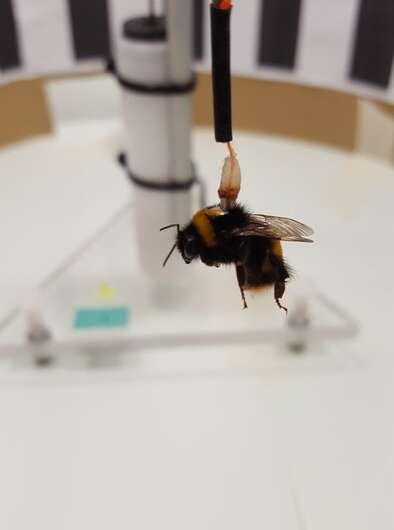Bee flight suffers under temperature extremes

Rising temperatures could help some northern-latitude bees fly better, but more frequent extreme weather events could push them past their limits.
Bees' flight performance affects their ability to pollinate plants—a crucial service for many of our crops. Now, researchers from Imperial College London have measured the relationship between bumblebee flight performance and surrounding temperature.
Measuring the motivation of bumblebees to fly and their flight endurance, the team found performance rose rapidly from the lower tested limit of 12°C and peaked between 25-27°C. Beyond this, however, they found performance started to decline.
Their results indicate that whilst bumblebees found in more northern latitudes may see benefits to flight performance under future climate warming, populations in southern latitudes, where temperatures above 27°C are more readily exceeded, may be adversely affected. The results are published today in Functional Ecology.
First author Daniel Kenna, from the Department of Life Sciences (Silwood Park) at Imperial, said: "Climate change is often thought of as being negative for bumblebee species, but depending on where in the world they are, our work suggests it is possible bumblebees will see benefits to aspects of an important behavior.
"However, more extreme weather events, such as cold snaps and the unprecedented heatwaves experienced in recent years, could consistently push temperatures beyond the comfortable flight range for certain species of bumblebees.
"These risks are particularly pertinent for 'fixed colony' pollinators like bumblebees, which cannot shift their position within a season if conditions become unfavorable, and potentially provide a further explanation as to why losses have been observed at species' southern range limits."
Like most flying insects, air temperature influences bees' body temperature, and body temperature influences flight activity. Too cold and their flight muscles can't function fast enough to support flight; too warm and they could overheat.
To measure how flight is determined by air temperature, the team temporarily attached bumblebees to 'flight mills', which allowed them to fly in circles like a carousel, capturing the distance and speed of flight. They tested bees ranging in body size at temperatures from 12-30°C and used their results to construct a thermal performance curve (TPC).
This TPC predicts that whilst bumblebees can fly around 3km at their thermal optimum, this average flight distance could be reduced to under 1km when temperatures rise to 35°C, and could plummet to just a few hundred meters at a chilly 10°C.
At temperatures of 15°C and below, the team observed that bees were demotivated to fly and frequently would not fly past 100m. Moreover, it was only the bigger sized bees that successfully flew at these low temperatures, suggesting smaller individuals dislike cold days but may benefit more from climate warming.
Lead researcher Dr. Richard Gill, from the Department of Life Sciences (Silwood Park) at Imperial, said: "While we still need to understand how these findings translate to factors like foraging return to colonies and pollination provision, as well as applicability to other bumblebee species, the results can help us understand how smaller versus larger flying insects will respond to future climate change.
"It's not just pollination: how different flying insects respond to warming temperatures could also affect the spread of insect-borne diseases and agricultural pest outbreaks that threaten food systems. Applying our experimental setup and findings to other species can help us to understand future insect trends important for managing service delivery or pest control methods."
The team are looking to expand this research to understand how climate warming and extreme weather events can influence the impacts of other stressors, such as pesticide exposure. They are also looking at how the impacts of warming can affect pollination delivery across different types of landscapes.
"Thermal flight performance reveals impact of warming on bumblebee foraging potential" by Daniel Kenna, Samraat Pawar & Richard J. Gill is published in Functional Ecology.Pesticide exposure causes bumblebee flight to fall short
More information: Daniel Kenna et al, Thermal flight performance reveals impact of warming on bumblebee foraging potential, Functional Ecology (2021). DOI: 10.1111/1365-2435.1388
Journal information: Functional Ecology
Provided by Imperial College London
No comments:
Post a Comment